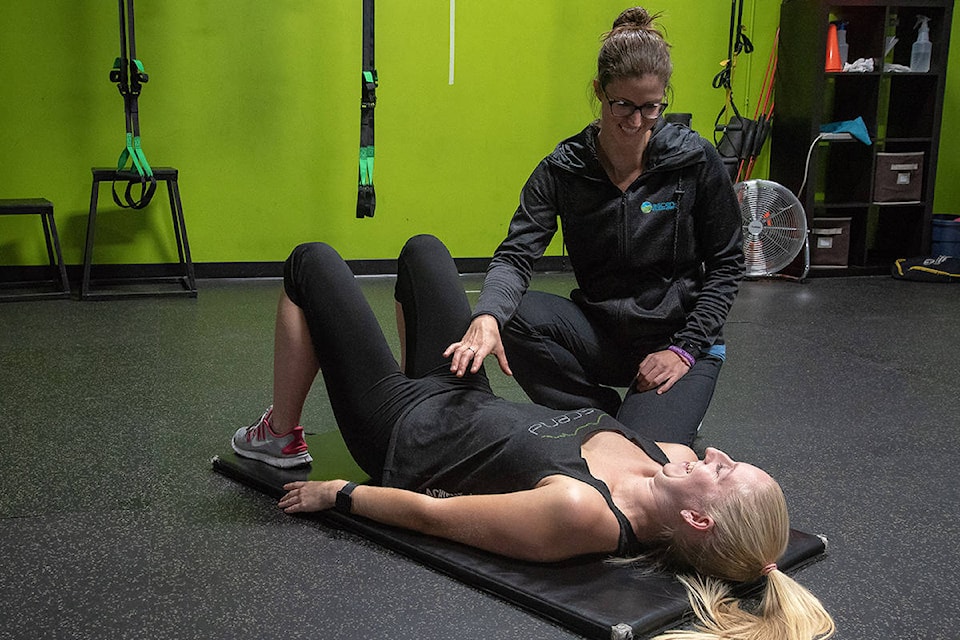By Tanja Shaw and Courtney Claggett
Special to The Progress
Training your core, the part of your body that connects your arms to your legs, has become a major focus in fitness. A strong core will improve your balance, posture, overall strength, and athletic ability. However, the physiology behind effective core training has been lost in the bustle of machines, fad fitness programs and infomercials which promise a trim waist and perky backside with four easy payments of $19.99. There are many myths and misconceptions about core training. Let’s bust some of them!
Myth No. 1: The core is another name for the abdominals.
The ‘core’ is made up of all the muscles which attach to the pelvis, hips, and spine, not just the abdominals. The core is a huge pressure system that stabilizes your spine. Think of a ‘canister.’ It includes the diaphragm, pelvic floor, deep abdominal muscles, and deep back muscles. When these areas work together, there is stability for the spine. These muscles are also directly connected to the hip flexors, hamstrings, buttock muscles and muscles of the neck, so they can greatly affect day to day movements.
Myth No. 2: Doing abdominal crunches will result in a strong core.
I understand the attraction to doing abdominal crunches, bicycle crunches, sit ups, v-sits and the like. We feel the ‘burn’ and therefore think that we’re doing something great for our body. Crunches target the rectus abdominis, the most superficial abdominal muscle (also known as the six-pack) and superficial neck muscles. The Rectus abdominus is only one superficial muscle of the entire core complex. Over-strengthening these muscles will lead to poor posture, muscle imbalances and back problems. Aim to strengthen all the muscles of your core for a balanced body.
Myth No. 3: Training your core will get rid of belly fat and give you a six-pack.
If only it were that easy! Core training targets your muscles, but muscles do not ‘own’ the surrounding fat. Typists do not get skinny fingers. A sensible diet and exercise regime will reduce the belly fat and expose the muscles underneath.
Myth No. 4: The best way to strengthen your core muscles is to isolate them with specific exercises.
Core muscles are essential for all movements, including walking, running, turning, bending, pushing and pulling.
They will be active and strengthened during all exercises and movements. If your core wasn’t active, you wouldn’t be able to move. However, with dysfunction in your ‘core canister’ there can be instability. That is why coordination with all areas is key in stabilizing. The first place to start would be your breath. While sitting, standing or laying on your back, inhale and let your belly expand. As you exhale, hollow your abdominals by drawing your belly button up towards your sternum (think of a gentle lifting). At the same time, contract your pelvic floor (think about gently trying to stop the flow of urine). Hold for the entire exhale, then relax and repeat. Practice breathing while working on the coordination of relax (pelvic floor) and expand diaphragm to inhale and engage (pelvic floor), contracting diaphragm, to exhale.
Myth No. 5: You should train your core every day.
Your core muscles are no different than any other muscle. They need rest to get stronger. You do use your core everyday, which is why these muscles do no need to be trained every day, but you should train them every other day. This will give your muscles time to recover.
Tanja Shaw is a Certified High Performance Coach, Nutritional Therapy Practitioner, host of the Fit and Vibrant You podcast and founder of Ascend Fitness + Lifestyle. Courtney Claggett is a Kinesiologist, and Post Natal Fitness Specialist, specializing in core stability and pelvic floor health. Learn more at ascendfitnesslifestyle.com.
